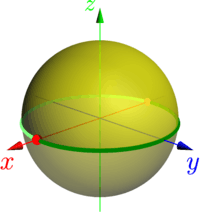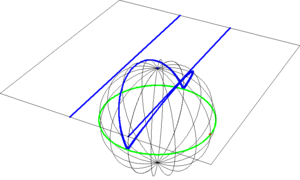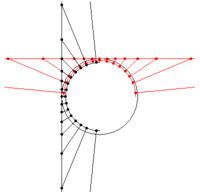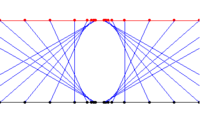Projective space

In mathematics, a projective space can be thought of as the set of lines through the origin of a vector space V. The cases when V = R2 and V = R3 are the real projective line and the real projective plane, respectively, where R denotes the field of real numbers, R2 denotes ordered pairs of real numbers, and R3 denotes ordered triplets of real numbers.
The idea of a projective space relates to perspective, more precisely to the way an eye or a camera projects a 3D scene to a 2D image. All points that lie on a projection line (i.e., a "line of sight"), intersecting with the entrance pupil of the camera, are projected onto a common image point. In this case, the vector space is R3 with the camera entrance pupil at the origin, and the projective space corresponds to the image points.
Projective spaces can be studied as a separate field in mathematics, but are also used in various applied fields, geometry in particular. Geometric objects, such as points, lines, or planes, can be given a representation as elements in projective spaces based on homogeneous coordinates. As a result, various relations between these objects can be described in a simpler way than is possible without homogeneous coordinates. Furthermore, various statements in geometry can be made more consistent and without exceptions. For example, in the standard Euclidean geometry for the plane, two lines always intersect at a point except when the lines are parallel. In a projective representation of lines and points, however, such an intersection point exists even for parallel lines, and it can be computed in the same way as other intersection points.
Other mathematical fields where projective spaces play a significant role are topology, the theory of Lie groups and algebraic groups, and their representation theories.
Introduction

As outlined above, projective space is a geometric object that formalizes statements like "Parallel lines intersect at infinity." For concreteness, we give the construction of the real projective plane P2(R) in some detail. There are three equivalent definitions:
- The set of all lines in R3 passing through the origin (0, 0, 0). Every such line meets the sphere of radius one centered in the origin exactly twice, say in P = (x, y, z) and its antipodal point (−x, −y, −z).
- P2(R) can also be described as the points on the sphere S2, where every point P and its antipodal point are not distinguished. For example, the point (1, 0, 0) (red point in the image) is identified with (−1, 0, 0) (light red point), etc.
- Finally, yet another equivalent definition is the set of equivalence classes of R3 ∖ (0, 0, 0), i.e., 3-space without the origin, where two points P = (x, y, z) and P∗ = (x∗, y∗, z∗) are equivalent iff there is a nonzero real number λ such that P = λ⋅P∗, i.e., x = λx∗, y = λy∗, z = λz∗. The usual way to write an element of the projective plane, i.e., the equivalence class corresponding to an honest point (x, y, z) in R3, is [x : y : z].
The last formula goes under the name of homogeneous coordinates.
In homogeneous coordinates, any point [x : y : z] with z ≠ 0 is equivalent to [x/z : y/z : 1]. So there are two disjoint subsets of the projective plane: that consisting of the points [x : y : z] = [x/z : y/z : 1] for z ≠ 0, and that consisting of the remaining points [x : y : 0]. The latter set can be subdivided similarly into two disjoint subsets, with points [x/y : 1 : 0] and [x : 0 : 0]. In the last case, x is necessarily nonzero, because the origin was not part of P2(R). This last point is equivalent to [1 : 0 : 0]. Geometrically, the first subset, which is isomorphic (not only as a set, but also as a manifold, as seen later) to R2, is in the image the yellow upper hemisphere (without the equator), or equivalently the lower hemisphere. The second subset, isomorphic to R1, corresponds to the green line (without the two marked points), or, again, equivalently the light green line. Finally we have the red point or the equivalent light red point. We thus have a disjoint decomposition
- P2(R) = R2 ⊔ R1 ⊔ point.
Intuitively, and made precise below, R1 ⊔ point is itself the real projective line P1(R). Considered as a subset of P2(R), it is called line at infinity, whereas R2 ⊂ P2(R) is called affine plane, i.e., just the usual plane.

The next objective is to make the saying "parallel lines meet at infinity" precise. A natural bijection between the plane z = 1 (which meets the sphere at the north pole N = (0, 0, 1)) and the sphere of the projective plane is accomplished by the gnomonic projection. Each point P on this plane is mapped to the two intersection points of the sphere with the line through its center and P. These two points are identified in the projective plane. Lines (blue) in the plane are mapped to great circles if one also includes one pair of antipodal points on the equator. Any two great circles intersect precisely in two antipodal points (identified in the projective plane). Great circles corresponding to parallel lines intersect on the equator. So any two lines have exactly one intersection point inside P2(R). This phenomenon is axiomatized in projective geometry.
Definition of projective space
The real projective space of dimension n or projective n-space, Pn(R), is roughly speaking the set of the lines in Rn+1 passing through the origin. For defining it as a topological space and as an algebraic variety it is better to define it as the quotient space of Rn+1 by the equivalence relation "to be aligned with the origin". More precisely,
- Pn(R) := (Rn+1 ∖ {0}) / ~,
where ~ is the equivalence relation defined by: (x0, ..., xn) ~ (y0, ..., yn) if there is a non-zero real number λ such that (x0, ..., xn) = (λy0, ..., λyn).
The elements of the projective space are commonly called points. The projective coordinates of a point P are x0, ..., xn, where (x0, ..., xn) is any element of the corresponding equivalence class. This is denoted P = [x0 : ... : xn], the colons and the brackets emphasizing that the right-hand side is an equivalence class, which is defined up to the multiplication by a non zero constant.
Instead of R, one may take any field, or even a division ring, K. In these cases it is common[1] to use the notation PG(n, K) for Pn(K). If K is a finite field of order q, the notation is further simplified to PG(n, q). Taking the complex numbers or the quaternions, one obtains the complex projective space Pn(C) and quaternionic projective space Pn(H).
If n is one or two, it is also called projective line or projective plane, respectively. The complex projective line is also called the Riemann sphere.
Slightly more generally, for a vector space V (over some field k, or even more generally a module V over some division ring), P(V) is defined as (V ∖ {0}) / ~, where two non-zero vectors v1, v2 in V are equivalent if they differ by a non-zero scalar λ, i.e., v1 = λv2. The vector space need not be finite-dimensional; thus, for example, there is the theory of projective Hilbert spaces.
Projective space as a manifold

The above definition of projective space gives a set. For purposes of differential geometry, which deals with manifolds, it is useful to endow this set with a (real or complex) manifold structure.
Namely, identifying a point of the projective space with its homogeneous coordinates, let us consider the following subsets of the projective space:
By the definition of projective space, their union is the whole projective space. Furthermore, Ui is in bijection with Rn (or Cn) via the following maps:
(the hat means that the i-th entry is missing).
The example image shows P1(R). (Antipodal points are identified in P1(R), though). It is covered by two copies of the real line R, each of which covers the projective line except one point, which is "the" (or "a") point at infinity.
We first define a topology on projective space by declaring that these maps shall be homeomorphisms, that is, a subset of Ui is open iff its image under the above isomorphism is an open subset (in the usual sense) of Rn. An arbitrary subset A of Pn(R) is open if all intersections A ∩ Ui are open. This defines a topological space.
The manifold structure is given by the above maps, too.

Another way to think about the projective line is the following: take two copies of the affine line with coordinates x and y, respectively, and glue them together along the subsets x ≠ 0 and y ≠ 0 via the maps
The resulting manifold is the projective line. The charts given by this construction are the same as the ones above. Similar presentations exist for higher-dimensional projective spaces.
The above decomposition in disjoint subsets reads in this generality:
- Pn(R) = Rn ⊔ Rn−1 ⊔ ⊔ R1 ⊔ R0,
this so-called cell-decomposition can be used to calculate the singular cohomology of projective space.
All of the above holds for complex projective space, too. The complex projective line P1(C) is an example of a Riemann surface.
Projective spaces in algebraic geometry
The covering by the above open subsets also shows that projective space is an algebraic variety (or scheme), it is covered by n + 1 affine n-spaces. The construction of projective scheme is an instance of the Proj construction.
Projective spaces in algebraic topology
Real projective n-space has a quite straightforward CW complex structure. That is, each n-dimensional real projective space has only one n-dimensional cell.
Projective space and affine space

There are some advantages of the projective space compared with affine space (e.g., Pn(R) vs. An(R)). For these reasons it is important to know when a given manifold or variety is projective, i.e., embeds into (is a closed subset of) projective space. (Very) ample line bundles are designed to tackle this question.
Note that a projective space can be formed by the projectivization of a vector space, as lines through the origin, but cannot be formed from an affine space without a choice of basepoint. That is, affine spaces are open subspaces of projective spaces, which are quotients of vector spaces.
- Projective space is a compact topological space, affine space is not. Therefore, Liouville's theorem applies to show that every holomorphic function on Pn(C) is constant. Another consequence is, for example, that integration of functions or differential forms on Pn does not cause convergence issues.
- On a projective complex manifold X, cohomology groups of coherent sheaves are finitely generated. (The above example is H0(Pn(C), O), the zeroth cohomology of the sheaf of holomorphic functions O). In the parlance of algebraic geometry, projective space is proper. The above results hold in this context, too.
- For complex projective space, every complex submanifold X ⊂ Pn(C) (i.e., a manifold cut out by holomorphic equations) is necessarily an algebraic variety (i.e., given by polynomial equations). This is Chow's theorem, it allows the direct use of algebraic–geometric methods for these ad hoc analytically defined objects.
- As outlined above, lines in P2 or more generally hyperplanes in Pn always do intersect. This extends to non-linear objects, as well: appropriately defining the degree of an algebraic curve, which is roughly the degree of the polynomials needed to define the curve (see Hilbert polynomial), it is true (over an algebraically closed field k) that any two projective curves C1, C2 ⊂ Pn(k) of degree e and f intersect in exactly ef points, counting them with multiplicities (see Bézout's theorem). This is applied, for example, in defining a group structure on the points of an elliptic curve, like y2 = x3 − x + 1. The degree of an elliptic curve is 3. Consider the line x = 1, which intersects the curve (inside affine space) exactly twice, namely in (1, 1) and (1, −1). However, inside P2, the projective closure of the curve is given by the homogeneous equation
- y2⋅z = x3 − x⋅z2 + z3,
- Any projective group variety, i.e., a projective variety, whose points form an abstract group, is necessarily an abelian variety. Elliptic curves are examples for abelian varieties. The commutativity fails for non-projective group varieties, as the example GLn(k) (the general linear group) shows.
Axioms for projective space
A projective space S can be defined axiomatically as a set P (the set of points), together with a set L of subsets of P (the set of lines), satisfying these axioms:[2]
- Each two distinct points p and q are in exactly one line.
- Veblen's axiom:[3] If a, b, c, d are distinct points and the lines through ab and cd meet, then so do the lines through ac and bd.
- Any line has at least 3 points on it.
The last axiom eliminates reducible cases that can be written as a disjoint union of projective spaces together with 2-point lines joining any two points in distinct projective spaces. More abstractly, it can be defined as an incidence structure (P, L, I) consisting of a set P of points, a set L of lines, and an incidence relation I that states which points lie on which lines.
The structures defined by these axioms are more general than those obtained from the vector space construction given above. If the (projective) dimension is at least three then, by the Veblen–Young theorem, there is no difference. However, for dimension two, there are examples that satisfy these axioms that can not be constructed from vector spaces (or even modules over division rings). These examples do not satisfy the Theorem of Desargues and are known as Non-Desarguesian planes. In dimension one, any set with at least three elements satisfies the axioms, so it is usual to assume additional structure for projective lines defined axiomatically.[4]
It is possible to avoid the troublesome cases in low dimensions by adding or modifying axioms that define a projective space. Coxeter (1969, p. 231) gives such an extension due to Bachmann.[5] To ensure that the dimension is at least two, replace the three point per line axiom above by;
- There exist four points, no three of which are collinear.
To avoid the non-Desarguesian planes, include Pappus's theorem as an axiom;[6]
- If the six vertices of a hexagon lie alternately on two lines, the three points of intersection of pairs of opposite sides are collinear.
And, to ensure that the vector space is defined over a field that does not have even characteristic include Fano's axiom;[7]
- The three diagonal points of a complete quadrangle are never collinear.
A subspace of the projective space is a subset X, such that any line containing two points of X is a subset of X (that is, completely contained in X). The full space and the empty space are always subspaces.
The geometric dimension of the space is said to be n if that is the largest number for which there is a strictly ascending chain of subspaces of this form:
A subspace in such a chain is said to have (geometric) dimension . Subspaces of dimension 0 are called points, those of dimension 1 are called lines and so on. If the full space has dimension then any subspace of dimension is called a hyperplane.
Classification
- Dimension 0 (no lines): The space is a single point.
- Dimension 1 (exactly one line): All points lie on the unique line.
- Dimension 2: There are at least 2 lines, and any two lines meet. A projective space for n = 2 is equivalent to a projective plane. These are much harder to classify, as not all of them are isomorphic with a PG(d, K). The Desarguesian planes (those that are isomorphic with a PG(2, K)) satisfy Desargues's theorem and are projective planes over division rings, but there are many non-Desarguesian planes.
- Dimension at least 3: Two non-intersecting lines exist. Veblen & Young (1965) proved the Veblen–Young theorem that every projective space of dimension n ≥ 3 is isomorphic with a PG(n, K), the n-dimensional projective space over some division ring K.
Finite projective spaces and planes

A finite projective space is a projective space where P is a finite set of points. In any finite projective space, each line contains the same number of points and the order of the space is defined as one less than this common number. For finite projective spaces of dimension at least three, Wedderburn's theorem implies that the division ring over which the projective space is defined must be a finite field, GF(q), whose order (that is, number of elements) is q (a prime power). A finite projective space defined over such a finite field has q + 1 points on a line, so the two concepts of order coincide. Notationally, PG(n, GF(q)) is usually written as PG(n, q).
All finite fields of the same order are isomorphic, so, up to isomorphism, there is only one finite projective space for each dimension greater than or equal to three, over a given finite field. However, in dimension two there are non-Desarguesian planes. Up to isomorphism there are
finite projective planes of orders 2, 3, 4, ..., 10, respectively. The numbers beyond this are very difficult to calculate and are not determined except for some zero values due to the Bruck–Ryser theorem.
The smallest projective plane is the Fano plane, PG(2, 2) with 7 points and 7 lines.
Morphisms
Injective linear maps T ∈ L(V, W) between two vector spaces V and W over the same field k induce mappings of the corresponding projective spaces P(V) → P(W) via:
- [v] → [T(v)],
where v is a non-zero element of V and [...] denotes the equivalence classes of a vector under the defining identification of the respective projective spaces. Since members of the equivalence class differ by a scalar factor, and linear maps preserve scalar factors, this induced map is well-defined. (If T is not injective, it has a null space larger than {0}; in this case the meaning of the class of T(v) is problematic if v is non-zero and in the null space. In this case one obtains a so-called rational map, see also birational geometry).
Two linear maps S and T in L(V, W) induce the same map between P(V) and P(W) if and only if they differ by a scalar multiple, that is if T = λS for some λ ≠ 0. Thus if one identifies the scalar multiples of the identity map with the underlying field K, the set of K-linear morphisms from P(V) to P(W) is simply P(L(V, W)).
The automorphisms P(V) → P(V) can be described more concretely. (We deal only with automorphisms preserving the base field K). Using the notion of sheaves generated by global sections, it can be shown that any algebraic (not necessarily linear) automorphism must be linear, i.e., coming from a (linear) automorphism of the vector space V. The latter form the group GL(V). By identifying maps that differ by a scalar, one concludes that
- Aut(P(V)) = Aut(V)/K× = GL(V)/K× =: PGL(V),
the quotient group of GL(V) modulo the matrices that are scalar multiples of the identity. (These matrices form the center of Aut(V).) The groups PGL are called projective linear groups. The automorphisms of the complex projective line P1(C) are called Möbius transformations.
Dual projective space
When the construction above is applied to the dual space V∗ rather than V, one obtains the dual projective space, which can be canonically identified with the space of hyperplanes through the origin of V. That is, if V is n dimensional, then P(V∗) is the Grassmannian of n − 1 planes in V.
In algebraic geometry, this construction allows for greater flexibility in the construction of projective bundles. One would like to be able associate a projective space to every quasi-coherent sheaf E over a scheme Y, not just the locally free ones. See EGAII, Chap. II, par. 4 for more details.
Generalizations
- dimension
- The projective space, being the "space" of all one-dimensional linear subspaces of a given vector space V is generalized to Grassmannian manifold, which is parametrizing higher-dimensional subspaces (of some fixed dimension) of V.
- sequence of subspaces
- More generally flag manifold is the space of flags, i.e., chains of linear subspaces of V.
- other subvarieties
- Even more generally, moduli spaces parametrize objects such as elliptic curves of a given kind.
- other rings
- Generalizing to associative rings (rather than only fields) yields, for example, the projective line over a ring.
- patching
- Patching projective spaces together yields projective space bundles.
Severi–Brauer varieties are algebraic varieties over a field k, which become isomorphic to projective spaces after an extension of the base field k.
Another generalization of projective spaces are weighted projective spaces; these are themselves special cases of toric varieties.[8]
See also
Generalizations
Projective geometry
Related
Notes
- ↑ Mauro Biliotti, Vikram Jha, Norman L. Johnson (2001) Foundations of Translation Planes, p 506, Marcel Dekker ISBN 0-8247-0609-9
- ↑ Beutelspacher & Rosenbaum 1998, pgs. 6–7
- ↑ also referred to as the Veblen–Young axiom and mistakenly as the axiom of Pasch (Beutelspacher & Rosenbaum 1998, pgs. 6–7). Pasch was concerned with real projective space and was attempting to introduce order, which is not a concern of the Veblen–Young axiom.
- ↑ Baer 2005, p. 71
- ↑ Bachmann, F. (1959), Aufbau der Geometrie aus dem Spiegelsbegriff, Grundlehren der mathematischen Wissenschaftern, 96, Berlin: Springer, pp. 76–77
- ↑ As Pappus's theorem implies Desargues's theorem this eliminates the non-Desarguesian planes and also implies that the space is defined over a field (and not a division ring).
- ↑ This restriction allows the real and complex fields to be used (zero characteristic) but removes the Fano plane and other planes that exhibit atypical behavior.
- ↑ Mukai 2003, example 3.72
References
- Afanas'ev, V.V. (2001), "projective space", in Hazewinkel, Michiel, Encyclopedia of Mathematics, Springer, ISBN 978-1-55608-010-4
- Baer, Reinhold (2005) [first published 1952], Linear Algebra and Projective Geometry, Dover, ISBN 978-0-486-44565-6
- Beutelspacher, Albrecht; Rosenbaum, Ute (1998), Projective geometry: from foundations to applications, Cambridge University Press, ISBN 978-0-521-48277-6, MR 1629468
- Coxeter, Harold Scott MacDonald (1974), Introduction to Geometry, New York: John Wiley & Sons, ISBN 0-471-18283-4
- Coxeter, Harold Scott MacDonald (1969), Projective geometry, Toronto, Ont.: University of Toronto Press, ISBN 0-8020-2104-2, MR 0346652, OCLC 977732
- Dembowski, P. (1968), Finite geometries, Ergebnisse der Mathematik und ihrer Grenzgebiete, Band 44, Berlin, New York: Springer-Verlag, ISBN 3-540-61786-8, MR 0233275
- Greenberg, M.J.; Euclidean and non-Euclidean geometries, 2nd ed. Freeman (1980).
- Hartshorne, Robin (1977), Algebraic Geometry, Berlin, New York: Springer-Verlag, ISBN 978-0-387-90244-9, MR 0463157, esp. chapters I.2, I.7, II.5, and II.7
- Hilbert, D. and Cohn-Vossen, S.; Geometry and the imagination, 2nd ed. Chelsea (1999).
- Mukai, Shigeru (2003), An Introduction to Invariants and Moduli, Cambridge Studies in Advanced Mathematics, Cambridge University Press, ISBN 978-0-521-80906-1
- Veblen, Oswald; Young, John Wesley (1965), Projective geometry. Vols. 1, 2, Blaisdell Publishing Co. Ginn and Co. New York-Toronto-London, MR 0179666 (Reprint of 1910 edition)
